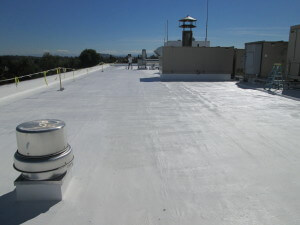SPF/Foam Roofs
Spray on Polyurethane Foam is used on buildings where energy consumption is important like a cold storage or large climate controlled facility like a hospital or film storage. When these buildings are designed, the HVAC systems are engineered with the “R” value of the roofing system in mind. The “R” value means its resistance to heat. For each inch of foam on the roof, it adds a value of R-6. To remove the foam from a roof may change the HVAC system function and bigger equipment may be needed to compensate for this. The problem with foam roofs is that they need a protective coating on them continuously to keep water out and to keep the sun from deteriorating the foam into dust. An uncoated foam roof is a giant sponge that can be damaged severely from water intrusion. Not only does it promote mildew and mold growth, but it also will leave huge holes in the foam from the evaporation process. The water heats up, turns into steam and as it pushes through the foam to the surface, it creates a void. Once the vapor is released, the hole where it collected remains. Another problem is birds love to peck at it. There are a couple of theories on this. One, is they feel vibrations and think there are bugs or worms in the foam. The other is that they use it for nesting. The bottom line is birds make thousands of holes in the foam even though it may have an acrylic on it. Ceramic pigments are thought to deter birds, the evidence shows they are ineffective. There are dimples throughout the roof field creating bird baths that hold little puddles of water. Warranties for acrylic coatings do not cover ponding water, so there would be no warranty on a flat foam roof.
The best solution is to in stall The SureCoat Roof System over a new foam roof and never have any of these problems. SureCoat flat roof coatings are also the solution to existing foam roofs that pond water. The SureCoat Roof System was originally created to take the place of 2-part coatings that are recommended over foam. These coatings are expensive, take special equipment and have a short pot life and workability. The SureCoat Roof System is the best system ever made for existing foam roofs. Besides being a great first coating, SureCoat can be used to repair and recondition a damaged foam roof. The first step is preparing the roof by addressing the holes, decayed foam, and peck holes. Once the repairs are complete, The SureCoat Roof System can be installed. Depending on the desired warranty, the high solid content of The SureCoat Roof System over foam provides about 45-65 dry mils, that alone deters birds from pecking at it. The elastomeric membrane is difficult for them to penetrate and they will give up.
stall The SureCoat Roof System over a new foam roof and never have any of these problems. SureCoat flat roof coatings are also the solution to existing foam roofs that pond water. The SureCoat Roof System was originally created to take the place of 2-part coatings that are recommended over foam. These coatings are expensive, take special equipment and have a short pot life and workability. The SureCoat Roof System is the best system ever made for existing foam roofs. Besides being a great first coating, SureCoat can be used to repair and recondition a damaged foam roof. The first step is preparing the roof by addressing the holes, decayed foam, and peck holes. Once the repairs are complete, The SureCoat Roof System can be installed. Depending on the desired warranty, the high solid content of The SureCoat Roof System over foam provides about 45-65 dry mils, that alone deters birds from pecking at it. The elastomeric membrane is difficult for them to penetrate and they will give up.
The SureCoat Roof System has a perm rating of .019 which is very low considering acrylics come in around 5.0 to greater than 25.0. This is the rate at which moisture passes through a surface. Ponding water over an acrylic is going to create water intrusion and all the problems that it welcomes. The seamless, waterproof, self-flashing, self-adhered SureCoat material provides the best protection from ponding water.
The SureCoat Roof System emits 93% of the heat that hits it, aiding the foam in lowering the demand on the HVAC system and cooling costs. The SureCoat Roof System reflects 81% of the sun’s UV rays that cause deterioration. This protects the delicate foam from heat and deterioration. Almost all of the initial testing values remain after 3 years as compared to other roof coatings and single ply materials that lose up to 20% or more. The single component, epoxy hybrid formula has a workability time of coatings, but bonding and binding abilities of 2-part epoxy systems. This allows adhesion to all types of surfaces including metals.
The HVAC plenums and duct work can also be coated to further lower cooling costs and extend the life of the equipment. The non-disruptive installation means the tenants can continue business as usual. The low VOC content is odorless to occupants. There are no toxic odors or fumes; the equipment on the roof does not need to be disconnected. The waterproof membrane will provide protection from the ponds that are typical on a flat roof. By forming a monolithic membrane over the roof field, there are no mastic seals around penetrations that will split or crack and allow water into the foam. Even roofs that have sustained water intrusion but have a stable roof deck can be reconditioned and protected. SureCoat Systems has solutions to address every problem encountered on a flat foam roof. Ponding water will not void the warranty. Tearing off and reinstalling a foam roof is extremely expensive. Using traditional materials would lead to inflated future roof budgets and possible additional expense to change the mechanical engineering of the facility.




